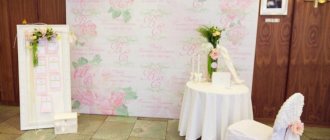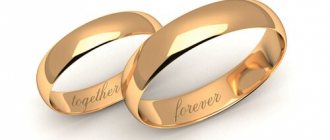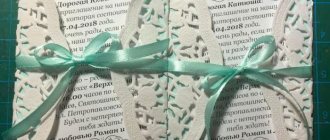Story
What is a towel? This is a piece of fabric made from hemp or linen threads, which is embroidered with all kinds of patterns.
It is believed that the word “rushnik” comes from the Ukrainian “rushai”, which literally translates as moving along your own path. There is also a possibility that the clue to the appearance of this word is in its root “rush” and means “to destroy, to break”, because initially the fabric on the towel was torn off by hand.
In ancient times, the bride herself had to make a towel for the wedding, as well as the rest of the outfits for this celebration, but if she could not cope with this task on her own, then the entire female family came to her aid.
Often there were even special family patterns that were passed down from generation to generation. Previously, the number of towels could be about 40, but now, as a rule, only three are needed: one is included in the wedding set, a loaf is placed on the other, and the hands of the third are tied.
What to do with the towel after?
After the wedding, all attributes, including the towel, are carefully stored in the house. This is not just a decoration and a reminder of a significant event in the life of the spouses. Wedding accessories are placed in a chest or hung in a prominent place. Some believe in the superstition that when storing an accessory, it should be twisted into a tube to protect the family from the evil eye and evil spirits.
The towel on which the newlyweds stood in the temple becomes a talisman of the family and a symbol of a strong marriage. It is customary to get it and use it during the wedding anniversary celebration.
Use in wedding ceremonies
- Under your feet. Since ancient times, a tradition has come to us: whoever stands first on the towel will be the master of the house. For such a towel, it was customary to embroider floral or geometric patterns, but to depict doves, which symbolized the newlyweds, or any wedding attributes, for example, rings. it was a bad sign; according to legend, young people could trample on their family future;
- Handmade. This was the largest and most richly embroidered towel; it was presented to the groom immediately after the matchmaking, as a sign of consent to marriage;
- Union towel. They bandage the hands of the newlyweds during marriage in the registry office or wedding in church. Such towels could be decorated with any patterns, wishes for future family life; traditionally white and red colors were used, sometimes adding black;
- Hospitable. As the name suggests, this towel was used to place a loaf of bread on it. On such a towel, as a rule, a pair of doves or swans was depicted, the towel was framed with patterns of flowers, trees and plants, as well as wedding rings, it was a symbol of a successful marriage;
- "Godmaker." This is the name of the towel, which is used for icons. Such towels were traditionally decorated with floral patterns, and before starting to work on it, it was necessary to pray. For the groom, oak leaves and grapes were usually embroidered on the towel; for the bride, flowers, usually roses or viburnum branches.
Selection rules
A towel is a symbolic attribute by which a couple’s future family life was judged, so the choice of this important accessory was taken seriously. For a wedding, only a towel made of solid fabric is suitable. There should be no lace or openwork inserts. A solid, uninterrupted ornament is also important, which symbolizes a long and happy marriage without shocks. Beliefs say that you should purchase or make your own towel with a geometric or floral pattern, choosing a design depending on its symbolism.
Beliefs
- During a clear starry night, the towel can be spread out on the grass, this is done so that life is as light and bright as the stars, and the girl is as fertile as the moon, after which the towel is dried under the rays of the sun, so that the family is warm and comfortable ;
- Before embroidering, you must wash your hands, thereby washing away bad thoughts;
- The greatest sacred power is found in wool and silk threads, and slightly less in cotton threads, so they should be used for towel embroidery;
- According to ancient beliefs, it is better to start embroidering early in the morning on Thursday; during needlework you need to drive away bad thoughts;
- If something was not done very carefully during embroidery, it was not corrected, so as not to introduce confusion into future life, especially since life consists of different moments and will never be ideal;
- For spiritual and material harmony, the drawings are made identical from different sides;
- But the middle of the towel should be empty, so that the path of life is easy and without obstacles;
- The reverse side of the towel is done extremely carefully; the threads should not cross, so that family life is not disturbed by gossip and evil tongues;
- The bride must stand on the left side of the towel, which, by the way, is embroidered second, and the groom, accordingly, on the right, with a part of the towel between them. Not filled with any decorations, as a symbol of a clean road;
- Towels are kept rolled up so that evil spirits can walk around and not disturb the family.
Price
A huge range of wedding accessories is presented in city and online stores. The cost of the attribute depends on the quality of the product, material, size. A hand-embroidered pattern is more valuable than a machine-made pattern. The price for a towel under your feet will average from 500 to 2000 rubles.
You can save a lot of money by embroidering a towel yourself. This is exactly what girls did in Rus'. The brides themselves chose the ornament, taking into account the symbolism of the patterns. It was believed that a towel embroidered by the bride would serve as a strong amulet for the family. Such an accessory was also an indicator of the girl’s hard work.
Natural threads - silk or wool - were used for embroidery. Acrylic patterns represented the artificiality of intentions and feelings. They embroidered towels during daylight hours and always in a good mood, so that their future family life would be happy and prosperous. It was recommended that work begin on Thursday morning. It is important to ensure that the back of the pattern is no less neat than the front side, so that the marriage proceeds evenly and smoothly.
Ornaments and patterns
- Grapes symbolize wealth and fertility;
- Kalina. This is a common Slavic symbol, but is most often referred to as a traditional Ukrainian pattern. It symbolizes female beauty, health and strength.
- Rose. One of the favorite embroidery patterns, which carries a symbol of rebirth, movement and the sun.
- Lily. Also one of the most popular flowers, which means purity and purity;
- Rooster. This bird promises happiness, wealth and prosperity;
- Mallow. Embroidered as a sign of the bride’s beauty and youth;
- Peacocks or firebirds. They carry constant development and symbolize a new family. Often viburnum branches were depicted in the beaks of birds, and wedding crowns above their heads;
- Cuckoo and nightingale. These birds were embroidered on towels, which were used before the wedding as a symbol of the single life of the bride and groom;
- Poppies. A rather rare symbol, it symbolizes wealth and feminine beauty.
- Oak. This tree is a symbol of masculine energy and wisdom;
- Hop cones. This symbol is close in meaning to grapes and means fertility and love;
- Tree of the genus. This is a talisman symbol that protects family well-being.
Nowadays, the need to embroider yourself has practically disappeared and brides most often are simply looking for where to buy a towel for a wedding or wedding ceremony, however, it is still worth knowing about the meanings of the patterns they choose.
A towel is an ancient amulet of family life, so you should not give up this tradition; it will become a good talisman for your family.
How to choose?
Based on the embroidered symbolic wedding attribute, they predicted how the future of the newlywed couple would develop together. Of course, the choice of such an accessory was taken very seriously and meticulously.
At a wedding ceremony, the towel should only be made of continuous seamless fabric, without lace or decorative inserts. The integrity of the ornament, which is considered a symbol of a long and happy marriage life, without breaks, is important. The durable cloth can be washed after the ritual and stored for use on all anniversaries in the future.
As legends say, it is worth buying or making a wedding towel with embroidered geometric figures in the ornament or with a pattern of plant motifs.
The pattern does not need to be symmetrical. Embroidery can be placed on both or one side. The main thing is that the middle is untouched. The center of the towel is God’s place, where the fabric is always without embroidery, pure from the “thoughts” of the embroiderers. This is because those getting married stand on the fabric with their feet in the center, which means they can tarnish their happiness. Any inscriptions are also unacceptable on such an accessory.
There are no standards applied to the size of the towel, but it is important to take into account that two people should fit comfortably on it - the bride and groom.
Traditionally, a snow-white towel or a cloth with a pink tint is chosen for a wedding. These colors represent purity of thoughts and tender feelings with which the future husband and wife, by the will of God and with his blessing, will go forward hand in hand, to a new life in a different status.
In the sacred interpretation, the white background of the embroidery means the heavenly clouds, onto which the newlyweds will ascend at the ceremony to conclude a union before the face of God.
Types of towels
Today, the number of wedding accessories has been simplified, leaving 6 mandatory varieties of sacred cloth. They accompany the key moments of the wedding:
- “hand-beaten” towel was given to the future parents of the groom. If the girl refused, she gave her a pumpkin; if she agreed, she gave her an embroidered towel.
- “The Blessed Ones” adorned icons with which parents instructed young people to live together in love and fidelity.
- A towel under the feet symbolized the beginning of a new life.
- The “allied” bandaged the hands of the bride and groom as a sign of unity. This tradition used to replace what wedding rings are made today.
- The “God’s” sacred cloth was intended to decorate the icons that the newlyweds held during the wedding.
- “hospitable” towel is the embodiment of wishes for prosperity and well-being. His embroidery differs from the rules for applying patterns.
The key role of the accessory is to attract wealth and demonstrate respect for another wedding shrine, the loaf.
Only women who were happy in their married life kneaded it, so no one else was allowed to take the wedding bread with their hands, it was considered a bad omen.
The loaf-style canvas is distinguished by lush patterns, inscriptions that come from antiquity, such as “Bread and Salt ,” and modern ones, for example, “Advice and Love!” .
Important! Previously, more attention was paid to this type of ritual towels: married couples were created not so much on the basis of mutual feelings, but on the material security of the other half. Thus, unmarried girls did not skimp on the beautiful design of the canvas, and the word “love” itself was not embroidered; it was embodied by a special ornament in the form of paired birds or flowers.
What should a traditional towel be like?
A towel for wedding bread looks like a piece of fabric, in the center of which there should be a loaf. The size of the accessory can be from 42 centimeters to 1.5 meters . The central part of the accessory remains free of embroidery. One fourth of the canvas on the left and right is occupied by patterns and inscriptions with wishes.
Since most modern couples at a wedding ceremony limit themselves to only a wedding towel for a loaf, the canvas is decorated with any embroidery: beads, wishes, symbols of marriage, roses, etc. .
In the photo and pictures below, examples of different options for towels for wedding bread and salt:











